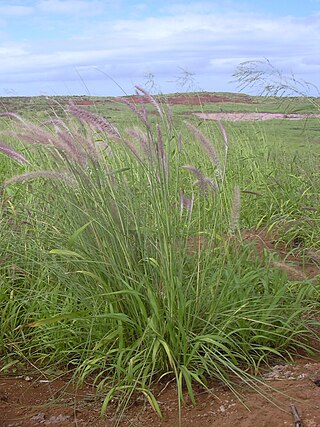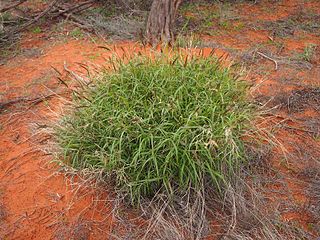
Sorghum or broomcorn is a genus of about 25 species of flowering plants in the grass family (Poaceae). Some of these species are grown as cereals for human consumption, in pastures for animals as fodder, and as bristles for brooms. Sorghum grain is a nutritious food rich in protein, dietary fiber, B vitamins, and minerals.

Avena is a genus of Eurasian and African plants in the grass family. Collectively known as the oats, they include some species which have been cultivated for thousands of years as a food source for humans and livestock. They are widespread throughout Europe, Asia and northwest Africa. Several species have become naturalized in many parts of the world, and are regarded as invasive weeds where they compete with crop production. All oats have edible seeds, though they are small and hard to harvest in most species.

Cymbopogon, also known as lemongrass, barbed wire grass, silky heads, oily heads, Cochin grass, Malabar grass, citronella grass or fever grass, is a genus of Asian, African, Australian, and tropical island plants in the grass family. Some species are commonly cultivated as culinary and medicinal herbs because of their scent, resembling that of lemons . The name cymbopogon derives from the Greek words kymbe and pogon "which mean [that] in most species, the hairy spikelets project from boat-shaped spathes." Lemongrass and its oil are believed to possess therapeutic properties.

Polytrias is a genus of Asian, African, and Pacific Island plants in the grass family, commonly called Java grass, Batiki bluegrass, Indian murainagrass, or toto grass. The only known species is Polytrias indica, native to West Africa, Seychelles, the Indian Subcontinent, southern China, Southeast Asia, New Guinea, Fiji, and Micronesia. It is also cultivated as a lawn grass in other tropical regions, and naturalized in scattered locations in tropical North and South America.

Lolium is a genus of tufted grasses in the bluegrass subfamily (Pooideae). It is often called ryegrass, but this term is sometimes used to refer to grasses in other genera.

Cenchrus setaceus, commonly known as crimson fountaingrass, is a C4 perennial bunch grass that is native to open, scrubby habitats in East Africa, tropical Africa, the Middle East and south-western Asia. It has been introduced to many parts of the world as an ornamental plant, and has become an invasive species in some of them. It is drought-tolerant, grows fast, reaches 3 feet in height, and has many purple, plumose flower spikes.

Pennisetum is a widespread genus of plants in the grass family, native to tropical and warm temperate regions of the world. They are known commonly as fountaingrasses. Pennisetum is considered a synonym of Cenchrus in Kew's Plants of the World Online.

Cryptostegia grandiflora, commonly known as rubber vine, is a woody-perennial vine that is native to south-west Madagascar. It is also a significant weed in northern Australia, sometimes regarded as the worst weed in all of Australia. It has also been introduced to most other tropical and subtropical regions by man, because of its attractive flowers and the fact that its latex contains commercial quality rubber. It is now naturalised in the Caribbean, East Africa, Mauritius, India, Southeast Asia, Indonesia, Latin America, the southern United States, Fiji and New Caledonia. It is very similar to the purple rubber vine, which is also native to Madagascar.

Cynodon is a genus of plants in the grass family. It is native to warm temperate to tropical regions of the Old World, as well as being cultivated and naturalized in the New World and on many oceanic islands.

Panicum (panicgrass) is a large genus of about 450 species of Poaceae grasses native throughout the tropical regions of the world, with a few species extending into the northern temperate zone. They are often large, annual or perennial grasses, growing to 1–3 m (3–10 ft) tall.

Cenchrus ciliaris is a species of grass native to most of Africa, southern Asia, southern Iran, and the extreme south of Europe (Sicily). Other names by which this grass is known include dhaman grass, anjan grass, koluk katai and buffelgrass.

Anthoxanthum, commonly known as hornworts, vernal grasses, or vernalgrasses, is a genus of plants in the grass family. The generic name means 'Yellow flower' in Botanical Latin, referring to the colour of the mature spikelets.

Bothriochloa is a common and widespread genus of plants in the grass family native to many countries on all inhabited continents and many islands. They are often called beardgrass, bluegrass or bluestem. Some species are invasive in areas where they have been introduced.

Dactyloctenium is a genus of Asian, African, and Australian plants in the grass family. There are about 13 species in the genus in the world, in which 3 are known to occur in India. A common name for the plants is crowfoot grasses.

Eleusine is a genus of Asian, African, and South American plants in the grass family, sometimes called by the common name goosegrass. One species (Eleusine indica), is a widespread weed in many places. Another species Eleusine coracana, is finger millet, cultivated as a cereal grain in India and parts of Africa.

Themeda is a genus of plants in the grass family native to Asia, Africa, Australia, and Papuasia. There are about 18 to 26 species, many of which are native to Southeast Asia.

Arthraxon, commonly known as carpetgrass, is a genus of Asian, African and Australian plants in the grass family, Poaceae, containing the following species:
Cleistachne is a genus of African and Asian plants in the grass family. The only known species is Cleistachne sorghoides, native to Eastern Africa and Southeastern Africa, and parts of Asia.

Dichanthium, known commonly as bluestem or bluegrass, is a genus of African, Asian, and Australian plants in the grass family.

Enteropogon is a genus of tropical and subtropical plants in the grass family. It is widespread across many parts of Asia, Africa, Australia, the Americas, and various islands.



















